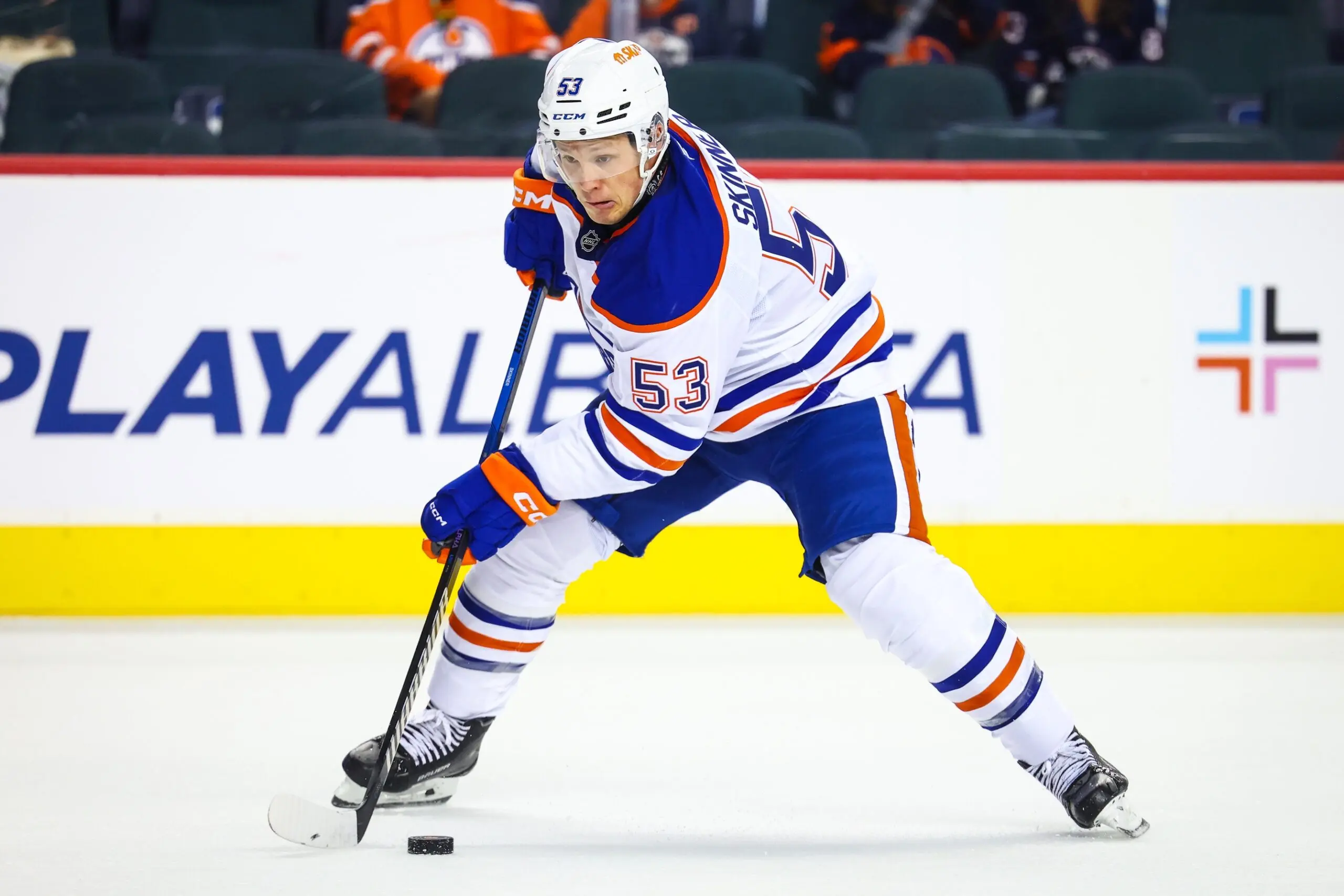Nation Sites
The Nation Network
OilersNation has no direct affiliation to the Edmonton Oilers, Oilers Entertainment Group, NHL, or NHLPA
Here’s what’s behind Jeff Skinner’s early-season struggles

Photo credit: © Sergei Belski-Imagn Images
Nov 16, 2024, 12:30 ESTUpdated: Nov 16, 2024, 13:26 EST
It’s been a tough start to the season for Edmonton Oilers forward Jeff Skinner.
In his first seventeen games since signing a one-year, $3 million deal with the Oilers in the summer, Skinner has scored three goals and made three assists, all at even-strength. His on-ice goal-differential at even-strength is currently -5 (6 goals for, 11 goals against), which translates to a 35 percent goals-for percentage that currently ranks second last among Edmonton’s forwards. Considering he’s played the sixth most minutes on the team (217) and ranks sixth in average ice time per game at even-strength (12.79), his results are a problem that’s hard to ignore.
Over the last few games, the coaching staff has started to sit Skinner more often at even-strength. In the last two games, Skinner has averaged less than nine minutes, which is about 17 percent of the Oilers total even-strength time. That’s well below the previous fifteen games where he’s averaged about 13 minutes a game, and 26 percent of the Oilers total even-strength time. The table below shows Skinner’s proportion of ice time per game in blue and the actual ice time per game in orange.

There are a couple of major issues with Skinner that have likely played a role in his decreased ice time.
One, Skinner just isn’t producing at the level and consistency that management was probably expecting from him. He’s scored three times on 44 shots so far – which is a shooting percentage of 6.82 percent. That’s well below the 10.98 shooting percentage he’s posted over his previous five regular seasons, and the 10.65 percent he’s posted over his fourteen-year career. The Oilers are currently near the bottom of the league in terms of team shooting percentage (6.68 percent) and are relying on Skinner to help turn those even-strength results around.

The other issue is that Skinner’s on-ice numbers at even-strength, relative to his team’s numbers, have been poor so far. Corsi (or shot attempts) and Expected Goals help us understand how well the team does at controlling the flow of play and out-chancing opponents with specific players on the ice. And it helps us uncover who could be helping drive play and opportunities for a team, and who might be dragging the team down.
Skinner would currently fall under this latter category as the team is posting an Expected Goals For percentage of 52.45 percent with him on the ice, which isn’t bad. But his team’s share of Expected Goals jumps to 57.98 percent when he’s on the bench. Below is a table with all of the Oilers’ forwards on-ice relative to team numbers, sorted by average ice time per game. A basic heat map is applied to each metric (green is good, red is bad) to give a sense of how each player compares to their teammates.

One issue with Skinner is that the team allows a significantly higher number of shots and chances against whenever he’s on the ice. For instance, without him on the ice, the Oilers allow about 23 shots against per hour. But when Skinner is on the ice, this rate jumps by about 25% to 30 shots against per hour. He’s one of the worst defensive forwards on the team, which isn’t overly surprising considering his previous teams have often allowed more shots when he’s on the ice. The difference in prior seasons was that he would help drive more offence and generate chances. But since he’s not having the same impact and the fact that his shooting percentage is down, he’s not providing a whole lot of value for the Oilers.
Worth noting that Ryan Nugent-Hopkins is also posting similar on-ice numbers as Skinner at even-strength, as the team tends to see a lot of chances against when he’s deployed. And it should probably be addressed by the coaching staff, considering he gets a lot of time in the top six with the star players. But because Nugent-Hopkins is on the first powerplay and kills penalties and has a +1 goal differential at even-strength, his underlying issues are likely going to be overlooked. At least for now.
As for Skinner, it’s understandable why the coaching staff has recently cut his minutes. His defensive play this season has been an ongoing issue, and it’s not just a couple of bad plays here and there that have led to this situation. Hopefully, there’s a plan in place to squeeze as much value out of Skinner as possible. But there’s also the harsh reality that Skinner’s defensive play has been a long-term issue over his previous seasons. And considering his age and the fact that he’s played over 1,000 NHL games, it’s hard to expect his defensive numbers to improve anytime soon.
Data: Natural Stat Trick
Presented by Amazon Prime Video
This Article is a Presentation of Prime Video. Catch Prime Monday Night Hockey, all season long. Claim your free trial today.
Breaking News
- Real Life Podcast: The Dave Chappelle show disaster, Jay’s trip to New York, and job interviews
- GDB 28.0: Oilers Need to Get Kraken (7 PM MT, SNW)
- Scenes From Morning Skate: Pickard gets the start despite Skinner’s recent performance
- Surely the NHL won’t use Italy rink concerns as a reason pull players from Olympics… right?
- Pre-Scout: Kraken coming off days of practice eyeing revenge against Oilers

